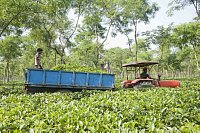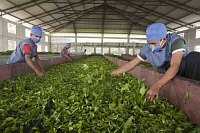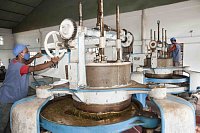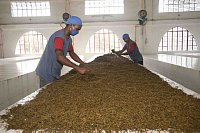At Teatulia®, we grow and process all of our teas at our USDA-certified organic tea garden in Northern Bangladesh’s Tetulia region. But how do our fresh, organic tea leaves get from our garden into your tea cup?
Types of tea processing
There are two basic methods of tea production: Orthodox and non-orthodox. Each method produces a very different final tea product.
Orthodox 
Whole Leaf: The orthodox method uses a process that preserves the integrity and flavor of the whole tea leaf throughout all stages of production.
Rolled & Shaped for Loose Leaf Tea: Whole tea leaves are carefully rolled or shaped into various sizes and styles depending on the type of tea being produced. Orthodox processing is used to produce various styles of loose leaf tea, including white, green, oolong and black.
Artisan Method: An artisan orthodox tea producer can greatly vary the outcome of a tea’s final appearance, aroma and flavor by how the tea leaf is shaped, oxidized and dried during the production process.
Complex Flavor: The orthodox method takes longer, but results in an attractive full leaf tea with complex flavor and aroma.
Non-orthodox 
Shredded Leaf: Also known as Crush-Tear-Curl, or CTC, non-orthodox processing yields small, intentionally shredded pieces of tea leaf that are shaped into granular pellets.
Made for Commercial Tea Bags: CTC was originally designed for the production of a strong, full-bodied black tea that could be packaged in traditional tea bags and stand up to the added milk and sugar in a brewed cup.
Machine Method: CTC is mainly a machine-driven production method created to eliminate some of the labor-intensive steps of the orthodox artisan method in order to speed up time to market for black tea production.
One-dimensional Flavor: The CTC process lacks the ability to produce a wide range of teas and tea flavors. Some green teas can be produced in this method, but white and oolong teas cannot. CTC is mainly a black tea production process because as the leaves are shredded, oxidation starts quickly. CTC-processed leaves are highly oxidized and they start loosing their essential oils immediately. Therefore, subtle nuances in aroma and flavor cannot be controlled, creating a final tea product with a one-dimensional profile.
Teatulia’s orthodox processing
Teatulia practices the orthodox method of tea production in order to preserve the whole tea leaf, control the outcome of the aroma and flavor of the final tea, and have the ability to produce a variety of tea styles from white to green to black.
At Teatulia we follow these key orthodox processing steps:
 Plucking |
 Weighing |
 Transporting |
 Withering |
 Rolling |
 Oxidizing |
 Firing |
 Sorting |
 Tasting |
- Plucking: Teatulia’s tea leaves are hand plucked by the local Bangladeshi men and women who cultivate our tea garden. While our tea bushes are very mature, they are kept pruned to waist-high height so that pluckers can easily access the leaves and buds from the youngest, newest growth near the top of the plant.
- Weighing: During a typical 8-hour workday in the tea garden, a plucker will fill several baskets with fresh tea leaves. When a basket is full, pluckers take the tea leaves to be inspected and weighed to make sure only the highest quality, undamaged tea leaves are chosen to be processed. On average, 22 to 25 kilograms of processed tea is manufactured from every 100 kilograms of fresh tea leaves.1
- Transporting: Newly plucked tea leaves are transported directly from our tea garden to our on-site production facility, where the inspecting, sorting and processing of the leaves into white, green or black tea begins immediately.
- Withering: Freshly plucked tea leaves are fragile and can easily break apart. So as a first step in processing, the leaves are laid out to dry for several hours so they will “wither” and loose some of their moisture content. Withering softens the tea leaves, making them flexible and supple so they won’t crumble during the rest of the processing steps.
- Rolling: This is where our Teatulia tea leaves start developing their unique appearance and flavor profiles. As the soft leaves are rolled and shaped by machine, the cell walls of the leaf are broken, releasing the enzymes and essential oils that will alter the flavor of the leaf. Rolling exposes the chemical components of the tea leaves to oxygen and initiates the oxidation process.
- Oxidizing: Oxidation is a chemical reaction that alters the flavor of tea and helps the processed tea develop its ultimate appearance and color. How long the tea leaves are allowed to oxidize, or be exposed to oxygen, will determine the type of tea the leaf will become. Black tea leaves are highly oxidized, and are therefore the darkest in color and strongest in flavor. Oolong teas vary in levels of oxidation, and therefore have varying colors and flavors, depending on the goals of the tea producer. Green and white teas are light in color and flavor because they are essentially non-oxidized.
- Firing: Firing initiates the final drying process. Once the leaf is oxidized to its desired level, we apply heat to the tea leaf to halt the oxidation process and further reduce the leaf’s moisture content so that the tea leaves can be stored without spoiling. Depending on the type of heat applied, firing can also lend some flavor characteristics to the final tea.
- Sorting: Once the tea leaves have dried, they are visually sorted into various groups of similar size and color to create different lots of like teas. These lots of tea receive different industry grades that rate how the tea visually looks depending on how much whole leaf, broken leaf or unopened tea buds end up in the lot. These grading systems don’t necessarily determine quality, though. The best measure of quality is how the final tea tastes.
- Tasting: Before any Teatulia tea travels from our organic garden to make its way into your tea cup, we carefully taste every lot to make sure it’s of consistently fresh and pure quality. Professional tasters inspect the appearance, aroma and flavor of the dry tea leaf, infused tea leaf and brewed tea liquor to make sure what you end up buying and brewing is the freshest Bangladesh tea available.
How do you get white, green and black teas from the same leaf?
From withering to drying, the same Camellia sinensis tea leaf is treated differently during the process to produce the very different aroma and flavor effects of white, green and black teas.
White: Green Bud → Withering (72 hrs) → Drying (110°C/65°C)
Our white tea is neither rolled nor fired, so it is essentially non-oxidized and it is the least processed. Instead of being exposed to an artificial heat, the leaves are simply allowed to wither and dry in a carefully controlled environment, which results in the most delicate, fresh-from-the-garden tasting tea.
Green: Steaming/Roasting → Cooling → 1st Rolling → 1st Drying (110°C/70°C) → Final Rolling→ Final Drying (120°C/80°C)
Our green tea is passed through a steaming treatment before rolling. Steaming applies light heat to the leaves to help halt the oxidation process before the leaves are rolled into shape. Steaming also helps expose the fresh, grassy flavor of the leaf. Green tea leaves are not allowed to oxidize after rolling, which is why they remain light color and flavor.
Black: Withering → 1st Rolling → Oxidizing/Fermenting → Drying (110°C/65°C)
Our black tea is rolled immediately after withering to help get the oxidation processes started quickly. The leaves are then fully oxidized before they are dried, which is how they get their dark color and rich flavor.
Sources:
1 School of Tea: http://www.schooloftea.org/tea-manufacturing-process/

